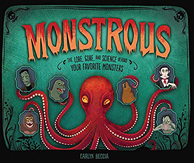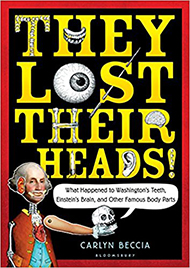I don’t know where March went, but I think I slept through most of it in a pregnancy induced stupor. I realized that I didn’t feature a new Raucous Book of the Month but I am really behind on deadlines and trying to get the newsletter out while it is still March. The giveaway this month will be Who Put the B in the Ballyhoo by yours truly. (This is my default giveaway when I am behind on reading)
But I shall make up for my laziness in the next few months because I have some fantastic giveaways coming up...
April
April will be all about those tantalizing Tudors. The Raucous Book of the Month and giveaway will be Alisa Libby’s The King Rose. I will also be giving away Season 1 and 2 of Showtime’s The Tudors.
May
It’s back to Louis XIV and a few other favorite French royals. The Raucous book of the month and giveaway will be Mistress of the Sun by Sandra Gulland. I will also be continuing the tale of Catherine de Medici which is long overdue.
June
I will be featuring Sideshow, Ten Original Tales of Freaks, Illusionists and other Matters Odd and Magical. In honor of this book, I will be covering everything wonderfully freakish at royal courts from dwarfs, astrologers and quack doctors to the most famous court jesters.
All newsletter subscribers are automatically entered to win the giveaways. If you are not a newsletter subscriber, then you can subscribe here. The giveaways are open to US, Canada and European Residents.
Lastly, Mistress of the Revolution is now available in paperback! If you like your love stories with a twist of Revolution fury then I highly recommend this book.
Catch me tomorrow for a guest post over at Doomed Queens on Anne of Cleves.
Tuesday, March 31, 2009
Thursday, March 26, 2009
Ask the Queen

Dear Anne Boleyn,
I have been dating the same guy for 2 months now and he wants me to be his mistress instead of his queen. What can I do to get him to commit? Could this be a sign that I am about to get the ax?
- Coquette
Dear Marie Antoinette,
I have been out of work for a month without a single baguette to eat. I have my first interview on Monday. Do you think my shiny white jumpsuit is the wrong fashion choice? What if I pair it with my feathered headdress? Too much for an interview?
-Philistine
Ever wonder what it would be like to step back in time and get love advice from Anne Boleyn? Or maybe you need some fashion tips from Marie Antoinette. Perhaps you just need a really tough royalty question answered. The above letters are some of the mind-boggling questions answered by royalty guru Kris Waldherr at Ask the Queens.
Just visit the site, submit your question and Kris Waldherr will solve all your royal dilemmas. More on how it works here.
Wednesday, March 25, 2009
The Tudors: Historical vs. Hollywood
 For the next few months, I am going to be doing a weekly blog posting about Showtime’s The Tudors that will cover what parts are Hollywood and what parts are based on real history.
For the next few months, I am going to be doing a weekly blog posting about Showtime’s The Tudors that will cover what parts are Hollywood and what parts are based on real history.If you have missed episode 1 and 2 then they are out on DVD or you can download them off of itunes. The official release date for the first episode of season 3 is April 5th but you can watch The Tudors from OnDemand now if you are a Showtime subscriber.
WARNING: THE FOLLOWNG CONTAINS SPOILERS. DO NOT READ FURTHER IF YOU HAVE NOT WATCHED EPISODE I OF SEASON 3.
Historical:
Behind the bodice ripping and way too pretty actors, The Tudors actually pulls together an amazing amount of historical details in the first episode of season 3. Let’s start with the truth….
 We start with the marriage of Jane and Henry followed by a sumptuous banquet (Jane’s marriage took place in the Queen’s Closet at Whitehall). Jane gets a new puppy and Edward Seymour is made Viscount Beauchamp. Jane has her first meeting with the ambassador to Spain, Chapuys. Henry is forced to interrupt the meeting when the conversation steers toward Jane being the pacific queen that unites daughter Mary with Henry. For lucky wife #3, Henry wants the misses to stay out of politics so he reminds Jane to keep her mouth shut or suffer the same fate as Anne. Jane’s coronation is then conveniently postponed due to plague. Soon Jane is feeling the pressure as Henry becomes disenchanted with his new motherless bride.
We start with the marriage of Jane and Henry followed by a sumptuous banquet (Jane’s marriage took place in the Queen’s Closet at Whitehall). Jane gets a new puppy and Edward Seymour is made Viscount Beauchamp. Jane has her first meeting with the ambassador to Spain, Chapuys. Henry is forced to interrupt the meeting when the conversation steers toward Jane being the pacific queen that unites daughter Mary with Henry. For lucky wife #3, Henry wants the misses to stay out of politics so he reminds Jane to keep her mouth shut or suffer the same fate as Anne. Jane’s coronation is then conveniently postponed due to plague. Soon Jane is feeling the pressure as Henry becomes disenchanted with his new motherless bride. Henry’s right hand man, Cromwell is made Lord of the Privy Seals, which basically means he has the power to sign important documents like which monastery to burn today. Cromwell justifies his actions by complaining about priests being caught with their pants down (true) and religious hoaxes swindling the people out of their pennies (true). We see a few very smoky monasteries in the background, some desecrated statues, and Cromwell cracks a joke about the holy bible doubling as both reading material and toilet paper. (People raiding the monasteries really were wiping their bottoms with it). The smell of burnt crucifixes makes the evangelistic Cromwell rather giddy until he angers a few disaffected Catholics (roughly 40,000). This might not have been such a problem if it were not for the fact that Henry had only about 10,000 loyal soldiers to fight. You can do the math. These “pilgrims” all have one basic goal in mind….Cromwell’s head on a stake.
Henry’s right hand man, Cromwell is made Lord of the Privy Seals, which basically means he has the power to sign important documents like which monastery to burn today. Cromwell justifies his actions by complaining about priests being caught with their pants down (true) and religious hoaxes swindling the people out of their pennies (true). We see a few very smoky monasteries in the background, some desecrated statues, and Cromwell cracks a joke about the holy bible doubling as both reading material and toilet paper. (People raiding the monasteries really were wiping their bottoms with it). The smell of burnt crucifixes makes the evangelistic Cromwell rather giddy until he angers a few disaffected Catholics (roughly 40,000). This might not have been such a problem if it were not for the fact that Henry had only about 10,000 loyal soldiers to fight. You can do the math. These “pilgrims” all have one basic goal in mind….Cromwell’s head on a stake. Robert Aske is forced into the role of leader and voice of the people. He looks like he is about to kill puppies instead of head up a rebellion. I thought The Tudors did an excellent job showing Aske’s dilemma of who to betray – his king or his religion.
Robert Aske is forced into the role of leader and voice of the people. He looks like he is about to kill puppies instead of head up a rebellion. I thought The Tudors did an excellent job showing Aske’s dilemma of who to betray – his king or his religion.Flash to a terrified Mary who is told that her head is going to resemble a boiled apple if she doesn’t recognize Henry’s annulment from her mother and his all important title of Supreme Head of the Church. Against her conscience, Mary decides to sign and a touching renewal between Father and daughter follows where Mary gets to pocket 1000 crowns and keep her head.
No one is hit harder than little Elizabeth who is living more like a pauper than a princess. Her governess Lady Bryan is forced to write a letter to Henry begging for some money for dresses. But Henry is not in a magnanimous mood because his festering leg wound is making him terrible grouchy and he still has no word of a future son.
Hollywood:
The following are scenes with a little Hollywood creative license…
Lady Rochford whines that Cromwell refuses to answer her letters and she is left without a penny to keep her living like a typical obsequious courtier. In truth, Jane Rochford wrote a groveling letter to Cromwell begging him to go to the king on her behalf so that she may secure her jointure. Although Cromwell did not get back Lady Rochford’s lands, he did secure for her an allowance of 100 pounds instead of 100 marks…. a significance raise. In fact, Lady Rochford most likely secured her position in Jane’s household through Cromwell. Even Cromwell could be a nice guy.
A quick word about Queen Jane's attire...although I love the sumptuous and colorful dresses that Jane wears throughout the episode, the truth is that she dressed more like a women stuck on a polygamous ranch than a fashionista. Jane banned French fashions including the more flattering french hood and dressed in all black insisting that her ladies do the same. But who wants to look at a court full of young ladies dressed in dowdy black?
Mary did recognize Henry as The Supreme Head of the Church but it was not really at the insistence of Chapuys. People like Nicholas Carew stood to lose much more if Mary did not sign. He was one of the many Catholics who begged Mary to sign. She really was feeling the pressure from all sides and I felt The Tudors could have dramatized this pressure a bit more. (The comment about Mary’s head turning into a boiled apple was also made by Norfolk and not Francis Bryan. ) Where did Norfolk go? I forget.
 Some serious license is taken concerning the Pilgrimage of Grace. In the Tudors, Brandon is asked to head up the army to end this whole messy business. In reality the Duke of Suffolk put down the Lincolnshire rebellion and the Duke of Norfolk out down the lengthier Northern rebellion. But alas, the producers probably knew that Henry Cavil (Brandon, Duke of Suffolk) would make a far sexier leader in these scenes. The Tudors has also compressed the rebellions to make the plot flow smoother. Technically, only the Northern rising is considered part of the "Pilgrimage of Grace" whose main objective was to take back 'the Cross of Christ'. The ring leaders in the Pilgrimage of Grace were Sir Robert Constable (NOT John Constable) and Robert Aske. Sir John Constable played a very minor role and was actually pretty adamant about not joining their cause.
Some serious license is taken concerning the Pilgrimage of Grace. In the Tudors, Brandon is asked to head up the army to end this whole messy business. In reality the Duke of Suffolk put down the Lincolnshire rebellion and the Duke of Norfolk out down the lengthier Northern rebellion. But alas, the producers probably knew that Henry Cavil (Brandon, Duke of Suffolk) would make a far sexier leader in these scenes. The Tudors has also compressed the rebellions to make the plot flow smoother. Technically, only the Northern rising is considered part of the "Pilgrimage of Grace" whose main objective was to take back 'the Cross of Christ'. The ring leaders in the Pilgrimage of Grace were Sir Robert Constable (NOT John Constable) and Robert Aske. Sir John Constable played a very minor role and was actually pretty adamant about not joining their cause. Probably the most disturbing distortion is the fact that Hollywood has aged Aske by about 30 years. In reality, Robert Aske was around 30 at the time of the rebellion. Aske’s age makes you wonder how he is going to survive the long tribulations ahead of him when he looks like he should be on social security. I am guessing that the producers wanted to cast Aske as the wise and older authority, but in reality he wasn’t sporting that much gray hair. The Tudor’s Aske also has both eyes in place while the real Aske was missing an eye. But you know Francis Bryan was notorious for his eye patch and we can’t have two people missing an eye because it might confuse viewers. hmmm
Probably the most disturbing distortion is the fact that Hollywood has aged Aske by about 30 years. In reality, Robert Aske was around 30 at the time of the rebellion. Aske’s age makes you wonder how he is going to survive the long tribulations ahead of him when he looks like he should be on social security. I am guessing that the producers wanted to cast Aske as the wise and older authority, but in reality he wasn’t sporting that much gray hair. The Tudor’s Aske also has both eyes in place while the real Aske was missing an eye. But you know Francis Bryan was notorious for his eye patch and we can’t have two people missing an eye because it might confuse viewers. hmmmIn the last scene, Henry threatens that Cromwell is going to be made a head shorter if he doesn’t put down the rebellion. In truth, Henry conquered the rebels by deception, not force. On the advice of Cromwell and Norfolk, Henry wrote a letter to the leaders agreeing to their demands. Aske returned to London and Henry conveniently changed his mind and had him executed (He’s the king…so he can do that). Because Cromwell’s advice saved the crown, Henry and him were as chummy as ever during this time. So although I appreciate Myers smoldering looks as much as the next person, I would have liked to seen a more 3- dimensional Henry here…someone capable of using political deception as easily as brute force. Maybe that is coming next episode?
 And lastly, the seductive Ursula is poor Hollywood invention, but I am really enjoying this addition because I don’t know what is going to happen. Stay tuned for Historical vs Hollywood to be posted after episode 2 airs on April 12th.
And lastly, the seductive Ursula is poor Hollywood invention, but I am really enjoying this addition because I don’t know what is going to happen. Stay tuned for Historical vs Hollywood to be posted after episode 2 airs on April 12th.Please also let me know if people are curious about which parts are accurate or if you rather just sit back and enjoy Henry Cavil getting all sweaty. If no one is interested then I am probably not going to continue this thread.
Tuesday, March 17, 2009
Grace O’ Malley: Queen Elizabeth’s favorite Irish Pirate Queen
 Few pirate tales are more legendary than the meeting at Greenwich Palace between Irish she captain Grace O’ Malley and Queen Elizabeth I. Fictional books, ballads, and art have certainly sentimentalized the meeting between the ‘wild Irish rose’ and ‘Gloriana’. But what is the real story behind this unlikely friendship?
Few pirate tales are more legendary than the meeting at Greenwich Palace between Irish she captain Grace O’ Malley and Queen Elizabeth I. Fictional books, ballads, and art have certainly sentimentalized the meeting between the ‘wild Irish rose’ and ‘Gloriana’. But what is the real story behind this unlikely friendship? The Irish Queen
The Irish QueenGrace O’ Malley (Grainne Mahal) was certainly not your typical swash buckling pirate. She was born in Ireland around 1530 to the O’Maille clan. From a young age, Grace was not the kind of woman to sit back and throw dinner parties at the castle. One story claims that when Grace’s father told her she could not accompany him on an expedition to Spain due to her long hair that she quickly solved the problem by chopping off her locks. (According to legend, this is how she earned the name Grainne Mahal because Maol means “bald” in Irish.) Another story claims that when her father’s ship was fleeing from the Algerian corsairs that Grace gave a final salute by pulling down her trousers and mooning her enemies. Another story claims that when the English seized the family galley, Grace jumped onto the back of an armed English sailor in an effort to save her father’s life. Tales like these tend to earn a gal respect amongst marauding pirates. So it isn’t hard to imagine that Grace gained quite a following by the time she reached adulthood.
Grace’s method of operation was similar to any pirate of the Renaissance. She would first lie in wait off the coast for slower merchant ships to cross her path. Then, she would seize the ships and negotiate a fee with the captain to continue on unharmed. If the captain of the captured ship refused, the plunder would follow. What made her legendary is that she was able to continue this dangerous lifestyle while avoiding being captured. Yet, it was all fun and games until Grace’s son, Tibbot, was captured in 1593 and her property was seized. Thus, Grace sailed to England to petition Elizabeth I for his release and the return of her property.
 The English Queen
The English QueenQueen Elizabeth had a somewhat hypocritical attitude toward her local pirates. Basically, any pirate that raided English ships was a treasonous rake. But any pirate that raided Spanish or French ships immediately became a friend and employee to England. (Bonus points were given if you brought her back some of that yummy tobacco from America that she so liked to smoke.) Grace had the potential to fall into the latter category of friendly pirate and it is for this reason that Elizabeth most likely granted Grace’s request for a meeting.
The Meeting
First hand accounts of the apocryphal meeting do not survive, but legend tells us that she appeared before the stiff-laced, bejeweled Elizabeth barefoot and in rags. They supposedly chatted in Latin, but what was said has been lost to history. What we do know is that Elizabeth agreed to all of Grace’s demands. Her son and property were to be restored and Grace was to continue her life of, “maintenance by sea and land.” This “maintenance” included the right to fight the Spanish and French on behalf of the English. (in other words, piracy).

As with many things concerning Elizabeth, we are left to guess as to why she granted Grace’s requests. It’s very tempting to imagine that Elizabeth as a powerful woman caught in a patriarchal society might have seen a bit of herself in this pirate queen. But I tend to think of Elizabeth as a pragmatist first and a feminist second. Firstly, Grace as friend over foe could only serve Elizabeth’s goals of filling the English coffers with stolen booty. And like Elizabeth, the 60-year old Grace was in the twilight of her years, and was therefore simply not much of a threat to English sovereignty. In a letter to Lord Bingham, Elizabeth reveals some of her attitude toward Grace when she wrote, “have pity for the poor aged woman.” (1) Perhaps Elizabeth painted Grace as a weak and feeble female because she knew it was the quickest way to divert attention? We will never know, but it’s hard not to romanticize these two aging warrior queens united together in one common goal: self-preservation.
If you are in the mood for a little Irish music this St. Patty’s day then I recommend listening to "Oró Sé do Bheatha 'Bhaile" which tells the tale of Grace O’ Malley. Happy St. Patty's day!
Notes:
(1) Sjoholm. P. 34
Sources and Further Reading:Sjoholm, Barbara. The Pirate Queen: In Search of Grace O’Malley and Other Legendary Women of the Sea, California: Seal Press, 2004.
Chambers, Anne. Ireland's Pirate Queen: The True Story of Grace O'malley, 1530-1603, New York: MJF, 2003.
Monday, March 16, 2009
Royal Salvation: A Brief History
 In the 15th century, a deeply superstitious population believed that hell looked something like the painting to the left. Eternal damnation was obviously much scarier then our consumer focused secular world. We worry about the economy. They worried about their souls. Covet your neighbor’s wife? Well, you just mind end up in the eternal fires of Hades with demons pecking out your brains. Ok a bit dramatic, but Bosch didn’t paint this painting because life was a bed of roses.
In the 15th century, a deeply superstitious population believed that hell looked something like the painting to the left. Eternal damnation was obviously much scarier then our consumer focused secular world. We worry about the economy. They worried about their souls. Covet your neighbor’s wife? Well, you just mind end up in the eternal fires of Hades with demons pecking out your brains. Ok a bit dramatic, but Bosch didn’t paint this painting because life was a bed of roses.Forgiveness Hurts
If you did sin, the first step in forgiveness was to show you were really, really sorry. Just pick up your whip and join the flagellants. All you needed was a rod and the ability to whip yourself repeatedly. King Henry III was a big fan of the movement.
 And like Henry, most people believed that their debauchery was forgiven once they whipped themselves into a frenzy. We can imagine that all that blood flying around probably only spread more plague and pestilence…the very thing people were hoping to stop.
And like Henry, most people believed that their debauchery was forgiven once they whipped themselves into a frenzy. We can imagine that all that blood flying around probably only spread more plague and pestilence…the very thing people were hoping to stop.Saint Relics… Your Mummy will heal you
Another way to reach divine forgiveness was to pray to the body part of a deceased saint. People traveled miles on pilgrimages to visit the toe or the finger of a beloved saint. Anne Boleyn got especially persnickety when she found out the nuns of Hailes Abbey were serving up duck’s blood instead of the blood of the blessed virgin. She ordered the virgin hoax removed.
Often, if a prince could not come to the saint, then you could always bring the saint to the prince. Such was the case with young heir of Philip II, Don Carlos who took a nasty tumble down the stairs while chasing a servant girl. His doctors prescribed an ingenious remedy – put the mummified body of saint Friar Diego in bed with the young prince. Ironically, Don Carlos did feel better after he slept with his mummy. Sorry…couldn’t resist.
 The Golden Ticket to Heaven
The Golden Ticket to HeavenPlaying on the fears of the people, Pope Leo X saw an ingenious way to fill the papal coffers back up with gold and goodies and save thousands of wary souls….papal indulgences. Papal indulgences usually looked like rolled up scrolls with the pope’s stamp of approval and cost just a few pennies. Anyone who purchased one could basically buy an entry to heaven and forgiveness. Steal your neighbors’ pig? No worries. Just pay the fiddler and you would be immediately forgiven. Papal indulgences became so popular that they even outsold the bible. And people not only bought them for the living, but also for the dead. It was believed a deceased relative could enter the pearly gates of heaven if they had a papal indulgence purchased in their name. Today we think we are lucky if we have life insurance, but 500 years ago people had death insurance.
Pope Leo X sent his friar, Johann Tetzel to do the dirty work of collecting money for indulgences throughout Germany. Everyone thought the money being raised was going toward St. Peter’s Basilica, but guess what? A huge junk was used to bankroll Leo’s soriees. Leo’s justification for his extravagances was really simple. He said, 'Since God has given us the papacy, let us enjoy it.' And enjoy it he did.
 The Door that Changed History
The Door that Changed HistoryBy the 16th century, one spunky monk named Martin Luther had had just about enough of the pope living like a rap star. Luther slapped his 95 Thesis on the door of Castle Church in Wittenburg condemning the sale of papal offices, indulgences, simony and the general widespread corruption. And the rest is a raucous tale…
Labels:
Henry III,
Martin Luther,
Medicine,
Pope Leo X
Thursday, March 12, 2009
Are you a Renaissance Beauty? Take the quiz and find out...
 Between perfectly bouncy locks and flawless skin, society today obviously values a pretty face. This beauty ideal is nothing new, but it has been redefined throughout history. Pressure to be beautiful in Renaissance Italy was especially cruel. In essence, Renaissance people were the ultimate victims of the Cinderella tale. Wicked and unchaste women were ugly. Virtuous women were beautiful.
Between perfectly bouncy locks and flawless skin, society today obviously values a pretty face. This beauty ideal is nothing new, but it has been redefined throughout history. Pressure to be beautiful in Renaissance Italy was especially cruel. In essence, Renaissance people were the ultimate victims of the Cinderella tale. Wicked and unchaste women were ugly. Virtuous women were beautiful.So what secured one woman a lucrative marriage and the next a one-way ticket to the nunnery? Luckily, Florentine writer, Agnolo Firenzuola put into writing the physical characteristics that made a woman beautiful. Take the following quiz and find out if you would be a beauty or a bawd....
Are you a Renaissance Beauty?
1. My forehead is:
A. Twice as wide as it is high
B. Half as wide as it is high
C. About the same in width and height
2. My hair color is:
A. Brunette
B. Red
C. Blond
D. Grey
E. Black
3. My eye color is:
A. Chestnut brown
B. Dark brown
C. Blue
D. Green
E. Hazel
4. My hair is:
A. Straight
B. Curly
C. Wavy
5. My nose is:
A. Short and small
B. Pointed and slender
C. As big as an Italian sausage
D. Upturned at the tip
6. My lips are:
A. Like a tiny rose bud
B. As big as my botox injection will allow
C. Thin
7. When I smile I…
A. Open my mouth wide
B. Open my mouth slightly
C. I don’t dare show my teeth
8. My complexion is:
A. Fair
B. Swarthy or dark
C. Peaches and cream
D. Medium
9. My eyebrows are:
A. Thick and full
B. Very thin and arched
C. What eyebrows? I plucked them off
10. My neck is:
A. Long and elegant
B. Short and stumpy
Score:
1) A = 2, B=0, C = 1
2) A = 0, B = 2, C = 3, D = -1, E=0
3) A= 3, B= 0, C=1, D= 0, E=2
4) A=0, B=2, C=1
5) A=0, B=2, C=0, D=0
6) A=2, B=0, C=0
7) A=0, B=2, C=1
8) A=3, B=0, C=2, D=0
9) A=0, B=2, C=1
10) A=2, B =0
23-17 points
You might have been Leonardo’s muse in another life. But before you get too cocky, remember that you would be positively washed-up by the age of 30. Hope that day has not come yet.
16-10 points
You may need a little help with some tweezers and lead make-up. Stay tuned for a future post on Renaissance beauty secrets.
9-0 points
Sheeesh…. You sure got hit with the 16th century ugly stick? Don’t worry. Perk up that Hapsburg chin and make sure to read the future post on Renaissance beauty secrets.
The Renaissance Beauty Ideal
Beautiful and virtuous women had a fair complexion with blond, curly hair, a long elegant neck and chestnut brown eyes. Their eyebrows were perfectly arched and thin and their foreheads should be twice as wide as they were high. (plucking helped). Our muse should also have a long, slender nose but it should not turn up at the end and her lips should be shaped like a delicate rosebud. She should have perfect teeth, but should never reveal them fully to her suitor. If she had bad teeth then she should keep her mouth closed at all times.
So how did you do?
Tuesday, March 10, 2009
GOOD NEWS!
I just found out that The Raucous Royals was winner of the International Reading Association's 2009 Children's and Young Adult Book Award for Intermediate-Nonfiction. They have not posted the other winners yet, but I will post a link and press release when I have it.
Friday, March 6, 2009
The Raucous Rumor of the Month: The sassy Christina of Milan snubs Henry VIII
 Good stories are often repeated. I am obviously very fond of this truism because it is the basis of my latest book. And as far as rumors go…. this one is just too tantalizing not to repeat.
Good stories are often repeated. I am obviously very fond of this truism because it is the basis of my latest book. And as far as rumors go…. this one is just too tantalizing not to repeat.This rumor surrounds the enigmatic Christina of Milan and her public rebuff of Henry VIII when he was seeking her hand in marriage. Christina is shown here demurely averting our gaze in a panting completed by Holbein in 1538. The painting was reportedly an accurate portrayal of her famed beauty despite first-hand accounts of a browner complexion.
At first glance, it’s hard to believe that the sweet, dimple-faced, 16 year old in the painting would dare to snidely insult the King of England. Yet, her slightly upturned smile seems to reveal a sardonic wit beneath the surface of her dutiful morning attire. This dry wit is most appropriately illustrated in Christina’s rumored response to becoming Henry’s wife that if she had two heads, “one should be at the King of England's disposal.” SLAM! Oh no she didn’t.
No, really… she did not.
The true story behind Christina and Henry’s proposed marriage doesn’t quite read like a Jennifer Aniston tabloid diss on Angelina Jolie. In fact, Christina of Milan may have been quite enamored with the idea of being the next Tudor rose. For one, queen of England was a big step up from a Duchess.
The only contemporary accounts of Christina's attitude toward Henry point to a sort of bemused curiosity and a submissive acceptance of her fate. When her attendant, Gran Battista Ferrari returned from his visit to England, Christina questioned him about Henry VIII. Their conversation was interrupted by a summons to supper, but she continued to question Ferrari afterwards. For someone supposedly repelled by the thought of marrying Henry, she was definitely curious. Later, Wriothesley asked Christina what she thought of Henry and she responded that she believed him to be a “noble prince” and that she would comply with the wishes of her uncle, Emperor, Charles V.
Some historians have argued that the length of time that Christina sat for Holbein (only three hours) is proof of her disinterest, but Holbein never took more than three to four hours to complete his sketches and then finished his paintings from these sketches. Such was also the case with the infamous portrait of Anne of Cleves later to become Henry’s 4th wife.
The real impediment to the marriage was not Christina’s lack of attraction to Henry, but the fact that Henry was attempting to dip his big, fat toe into his ex wife’s family gene pool. Christina of Milan just happened to be the great-niece of Catherine of Aragon thereby putting her in the forbidden degrees of affinity. The only way to marry Christina would have been for Henry to get a papal dispensation from Pope Paul III. Unfortunately, Paul was not about to give Henry any more free passes to marry. In fact, he actually went out his way to block the marriage by reissuing his trusty papal bull excommunicating Henry. And since Charles V had grown pretty chummy with the Pope he was not about to let his niece marry someone the Pope had publicly denied important sacraments…like the sacrament of marriage.
Henry was left with no other choice, but to marry someone outside of his family. Thus, he was stuck with Anne of Cleves – a story for another day.
Rumors that Christina was blatantly opposed to the marriage were floating around in the 16th century, but the two-headed comment was not recorded until the 17th century. Although Christina never had the gumption to make the famed remark, we can always find truth in every fiction. The rumor is an accurate reflection of the 16th century world attitude toward Henry seeking a 4th wife. Most people thought he did need a wife with two heads.
Warnicke, Retha M. The Marrying of Anne of Cleves: Royal Protocol in Early Modern England, Cambridge University Press, 2000
Fraser, Antoinia. The Six wives of Henry VIII, New York, NY: Vintage, 1993.
Subscribe to:
Posts (Atom)











